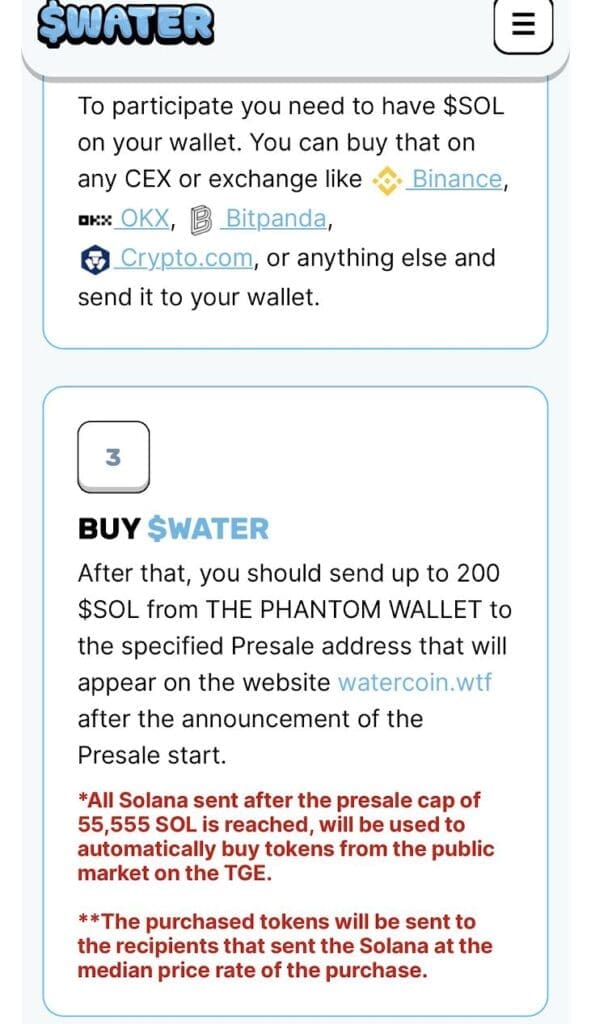As part of our ongoing efforts to provide investors and enthusiasts in the cryptocurrency world with reliable and detailed information, PayRate42 conducted a thorough practical review of the Watercoin ICO. Our goal was to document and critically evaluate the entire process to assess user-friendliness and adherence to the promises made. Watercoin, a heavily promoted project in the crypto community, raised high expectations and proved to be an exciting but also challenging event. This analysis provides a comprehensive overview of the ICO process, highlights the strengths and weaknesses, and offers valuable insights into the actual experiences of the participants.
The Pre-Sale Begins
The pre-sale of Watercoin was announced on the official website, attracting significant interest in the crypto community even before it started. The pre-sale began with a fixed timeframe, ending on June 21 at 4:00 PM London time. At the end of this period, a wallet address appeared on the website, to which interested buyers could send Solana (SOL) to secure pre-sale tokens. However, the announcement and process lacked transparency, leading to initial uncertainties.
Pre-Sale Conditions
The pre-sale rules were clearly defined but not without criticisms:
- There was a cap of 55,000 Solana. Once this limit was reached, the pre-sale ended. This caused concerns among investors as it was unclear how close they were to the cap.
- Each wallet could send a maximum of 200 Solana.
- While this limit was understandable, larger investors felt constrained.
- Whether pre-sale tokens had been received was not immediately communicated, adding to the uncertainty.
The Process in Detail

1. Setting Up a Phantom Wallet: Interested buyers first had to set up a Phantom Wallet, which is specifically designed for trading Solana and related tokens. The setup was straightforward, but there was insufficient support for less tech-savvy users, increasing the entry barrier unnecessarily.
2. Purchasing Solana: Next, participants had to purchase Solana (SOL) through an existing exchange like Kraken.
3. Transferring to the Phantom Wallet: The purchased Solana was then transferred from the exchange to the newly set up Phantom Wallet. This step was generally trouble-free but would have benefited from better guidance.
4. Transaction to the Pre-Sale Wallet: Participants then sent the Solana from the Phantom Wallet to the pre-sale wallet address provided on the website. This was a simple wallet transaction but created uncertainty among many users due to a lack of clear instructions. Watercoin’s communication at this stage was inadequate and needed improvement.
5. Receiving Pre-Sale Tokens: Pre-sale tokens were supposed to be transferred to participants’ Phantom Wallets after the ICO. However, this did not happen immediately, leading to significant frustration and uncertainty. The lack of immediate transaction confirmation was a major flaw in the process.
6. Trading Tokens:: Once the pre-sale tokens appeared in the Phantom Wallet, participants could trade them for Solana. However, the delays adversely affected the trading, angering many participants. These delays could have been avoided with better planning and communication from Watercoin.
PayRate42’s Experience
We, at PayRate42, participated in the pre-sale and successfully acquired tokens. The pre-sale was sold out in just 3 minutes. We received 396,226 tokens for 3.37676 Solana, which means we paid 0.000008522307976 Solana per coin, equivalent to $0.001176078500688 per coin.
The ICO Launch
The official launch of the Initial Coin Offering (ICO) was scheduled for June 24 at 4:00 PM London time. Watercoin’s team promised that pre-sale tokens would be transferred within an hour of the ICO’s start. This promise proved unrealistic, leading to growing frustration among participants.
Delays and Rising Tension

After the ICO launched promptly at 4:00 PM on June 24, many buyers waited impatiently for their pre-sale tokens. Despite the initial promise that all tokens would be transferred within an hour, significant delays ensued. Early reports suggested it could take up to five hours to transfer all tokens, highlighting clear organizational weaknesses on Watercoin’s part.
Price Surge and Growing Unrest
While pre-sale buyers waited for their tokens, Watercoin’s value surged up to +400%. This rapid price increase heightened tension and unrest among buyers, who feared losing valuable trading time. The lack of communication and transparency during this period exacerbated the uncertainty.
Final Transfer of Pre-Sale Tokens
It wasn’t until 10:00 PM London time that all pre-sale tokens were finally transferred. By this time, the coin was still up by over +200%. Despite the delays and initial uncertainty, many buyers were satisfied with their investment, as the coin’s value remained significantly higher than at the ICO’s start. Nevertheless, these delays were avoidable and tarnished the process.
Selling Experience
We received our tokens five hours later than expected, which were then sent to our Phantom Wallet. After receiving them, we could only sell our Watercoins for Solana through the Phantom Wallet. This process took seconds, and the demand was substantial. It’s noteworthy that many Memecoins struggle to find buyers, leaving investors stuck with their holdings. After selling our tokens for Solana, we transferred the Solana back to our Kraken wallet. The Phantom Wallet, an app designed specifically for trading Memecoins, facilitated this process.
Connections to BeerCoin

It is important to note that Watercoin followed a similar pattern to Beercoin, which was also managed by the same issuers. Beercoin, initially successful, eventually experienced a “rug pull.” A rug pull is a malicious maneuver in the cryptocurrency industry where developers abandon a project and run away with investors’ funds. Within 48 hours after the ICO, Watercoin’s value plummeted from $0.00734 to $0.00238, representing a decrease of approximately 67.6%. At the moment it doesn’t look like a rug pull like their previous project BeerCoin but we will continue to follow the project.
Conclusion
The Watercoin ICO presented several challenges and learning opportunities. While the pre-sale rules were clear, the significant delays in token transfers and the resulting uncertainties exposed major flaws in execution. Watercoin’s communication was poor, contributing to participant insecurity.
